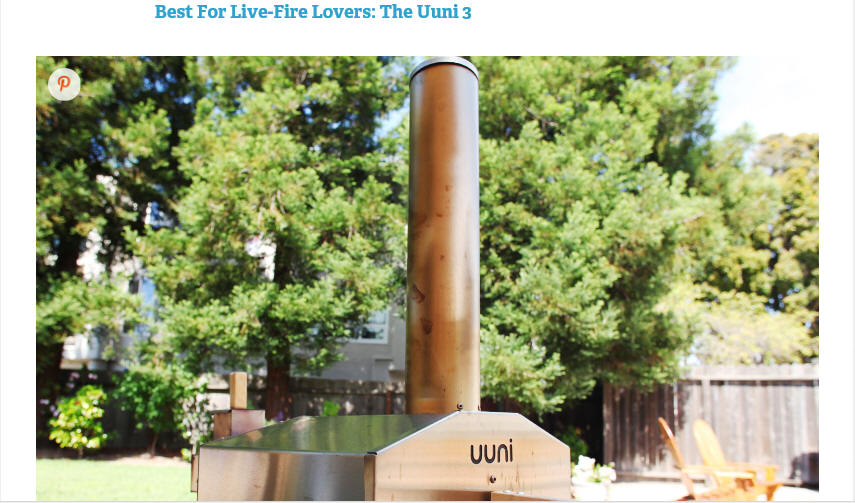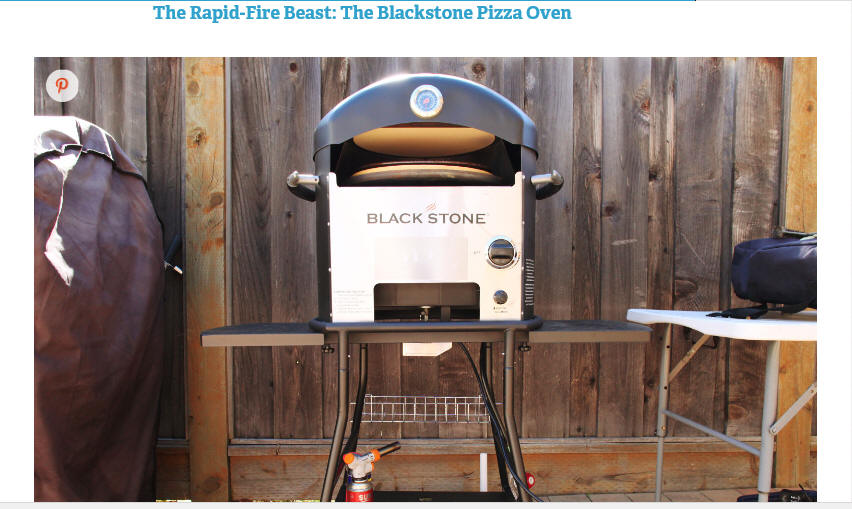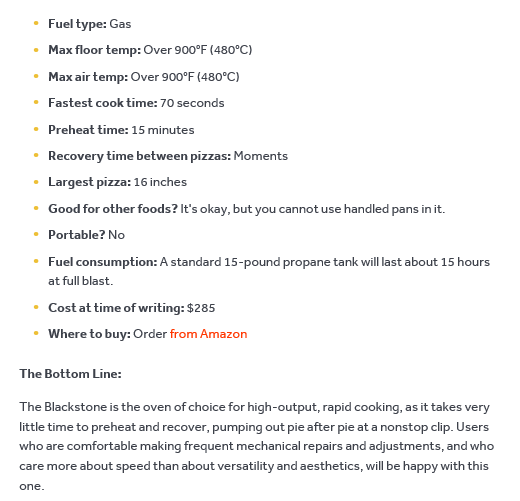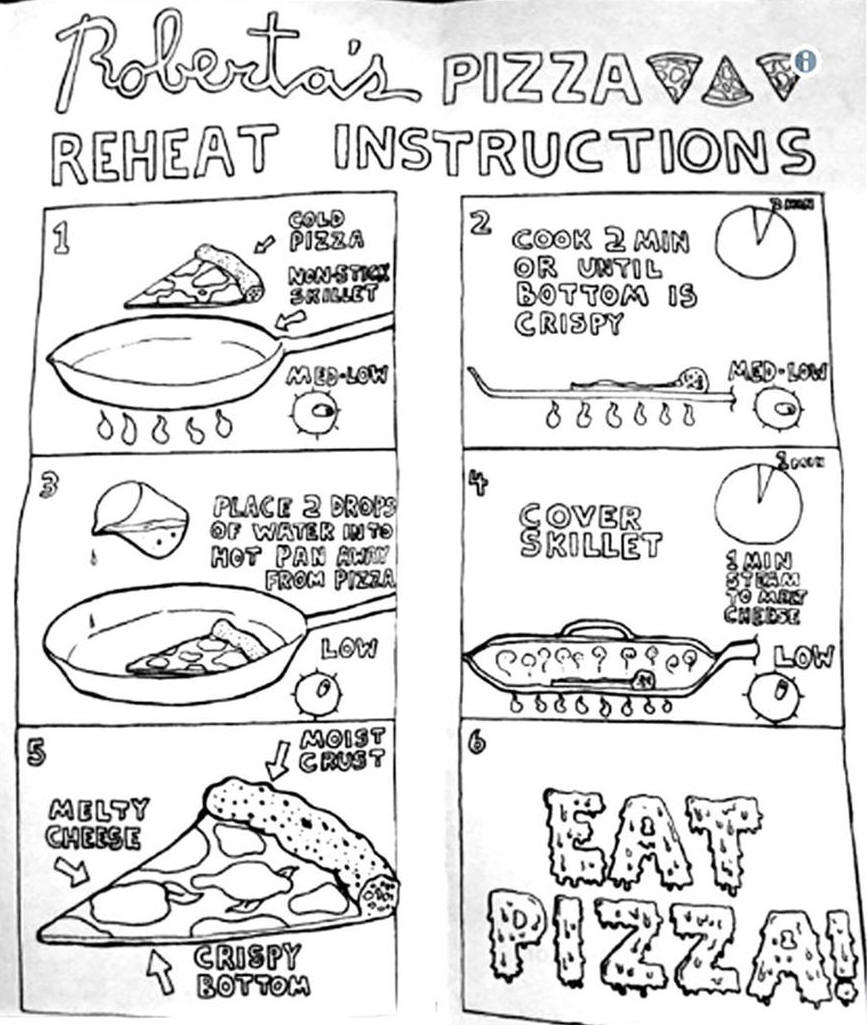
Pizza Ovens/Notes





The Bottom Line:
The Blackstone is the oven of choice for high-output, rapid cooking, as it takes very little time to preheat and recover, pumping out pie after pie at a nonstop clip. Users who are comfortable making frequent mechanical repairs and adjustments, and who care more about speed than about versatility and aesthetics, will be happy with this one.
How It Works:
The Blackstone pizza oven has a unique design. Rather than trying to heat an entire chamber, it instead has a single, extremely large gas flame that heats up a rotating turntable holding a pizza stone. Half of the flame hits the underside of the turntable to heat the base, while the other half of the flame is deflected up and over the top of the turntable to cook the top of the pizza. The turntable is rotated with a motor that runs on a couple of batteries or an adapter.
The oven sits on top of a large wheeled cart, and, unless you're willing to build a custom base for it, that's where it's gonna stay. It cannot be placed on a tabletop.
The Best Bits:
The first time you fire this one up, get ready, because it looks and sounds like a jet engine. The flame is big, and within 15 minutes or so, the stone is heated hot enough to crisp up the bottom of a pizza in under 90 seconds. The flame arcing over the top produces gorgeous leopard-spotting and a crisp, poofy crust. In most pizza ovens, the stone is heated indirectly from the hot air above it. The Blackstone, on the other hand, directly heats the stone from underneath, which means that, of all the ovens I tested, it had by far the fastest recovery time. You can cook pizzas one after the other, with virtually no wait in between.
The Minor Problems:
I have a few little issues with the Blackstone. The first is aesthetic. This thing is not attractive, and, unless your backyard is decorated to look like the cheap-grill display in the parking lot of a Home Depot, it's gonna stick out. The large stickers placed on the front of the unit before shipping also leave huge marks on the brushed metal. Performance should trump good looks, but I sure wish they could have made it look just a little bit better.
The second is that it's not great for cooking other foods. Sure, the opening is large enough that you can fit some fillets of fish or a bunch of vegetables, but because the stone rotates, you can't use any pan with a handle. This is a big inconvenience for someone like me, who likes to use their cast iron pans with their outdoor tools.
Flame management can be a little bit tricky. In many cases, I found that the bottoms of the pizzas cooked almost too fast, turning dark and burnt in spots by the time the tops were done. I resorted to using a pizza screen, placing the pizza on it halfway through cooking to keep it from coming in direct contact with the pan.
It's difficult to adjust this thing to anything other than blazingly hot, which is okay for Neapolitan-style pizza, but bad news if you want to cook a style that takes a bit more time, like a New York or Midwest thin-crust. Turning the adjustment knob down lowers the flame, but, since it heats from below, a low flame means you end up with plenty of heat still hammering the bottom of the pizza and almost none cooking the top.
The Major Problems:
The biggest downside? Durability. The Blackstone pizza oven is built from folded sheet metal, with an inexpensive burner and a cheap motor. In fact, during the couple months of my testing, three separate parts failed. The weak motor that runs the turntable started skipping the second time I fired it up, requiring me to coat everything in a layer of WD-40. By the fourth session, it had stopped turning altogether, resulting in the flame overheating one side of the turntable and warping it so that it no longer spun around steadily. I had to manually turn the hot wheel to finish up a pizza that was in the oven.
To solve this problem, I straightened out the turntable, then replaced the cheap motor with the rotisserie motor from my Coyote Outdoor Living grill. It's running smoothly now. Luckily, the motor is a standard three-inch motor mount, with a 5/16-inch square drive. This looks to be the exact motor assembly I used.
Online reports show that this is not an isolated incident, and many users resort to installing after-market thrust bearings to fix the problem, though, when I tried to do the same, I found that the axle on the turntable could no longer reach the motor assembly. Apparently, the new Blackstone models no longer work with the thrust bearing modifications. Jeff Krupman has been using Blackstones for catering jobs for a number of years, but, as he confirmed, he always carries a few spare motors with him, just in case one conks out in the middle of service.
Aside from the crummy motor, the stone the oven came with cracked neatly in two after about a half dozen uses (not a huge deal, as the stone continues to work, but still), and the "heatproof" paint on the interior of the oven is flaking and chipping as well.
The Blackstone does a great job of making quick pizzas with minimal fuss, but if the price seems too good to be true, it's because it is. You're going to need to do some work on it yourself and order some upgraded parts to get it in prime working condition. Adding a better motor to your order is a good start.
